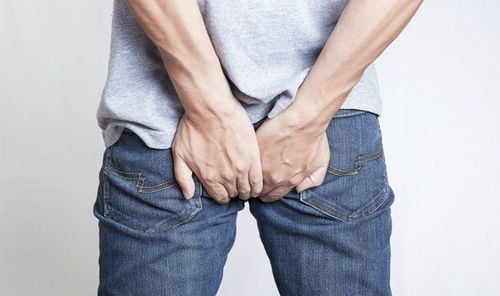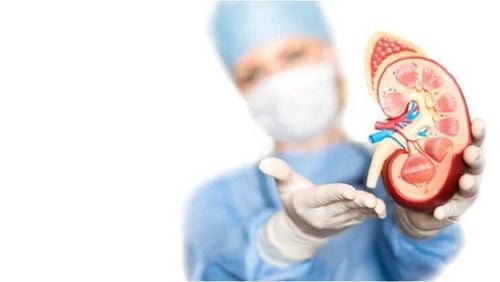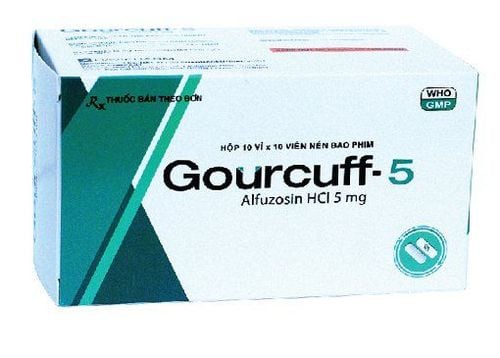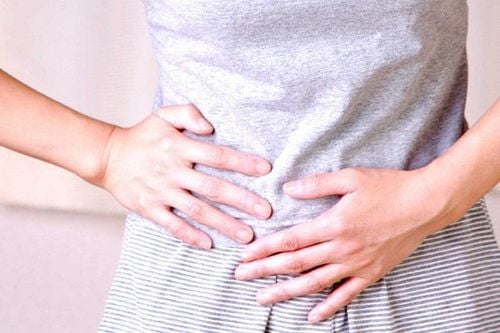This is an automatically translated article.
Urine crystal formation is a warning sign of the risk of kidney stone formation and associated infectious complications if not examined and treated early. Urine crystals are determined by performing a urinalysis.1. Why are there crystals in the urine?
Urine crystals are the solidification of chemicals in the urine. It can be found in the urine of healthy people due to minor problems such as excess protein or excess vitamin C. Many types of urine crystals are relatively harmless.
However, in some cases, urine crystals can be a sign of serious health problems, especially when accompanied by symptoms of fever, abdominal pain, blood in the urine, jaundice , tired.
Visually, urine with sediment can be a sign of crystals in the urine. Sedimentation in the urine can warn of many urinary tract diseases, you should see a doctor and treat it soon.
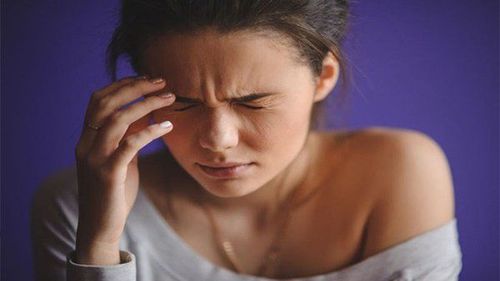
Tinh thể nước tiểu có thể là dấu hiệu của các vấn đề sức khỏe nghiêm trọng
2. Types of urine crystals
2.1. Uric Acid Crystals of uric acid exist in many different shapes such as barrel, plate, diamond shape and are usually orange-brown or yellow in color. In normal people, they can be found in the urine as a result of eating a high-protein diet.
Uric acid crystals can also appear in kidney stones, gout, chemotherapy or tumor resorption syndrome. Signs of kidney stones include severe pain in the abdomen, flank or groin, nausea, and blood in the urine. Gout is characterized by pain, stiffness, and swelling in the joints.
Treatment depends on the cause of the increase in uric acid in the urine, in which the best way is to maintain adequate water supply for the body.
2.2. Calcium oxalate Calcium oxalate crystals are shaped like dumbbells or envelopes, are colorless and can be found in the urine of healthy people. Too many calcium oxalate crystals in the urine can cause kidney stones. Kidney stones present with severe groin or abdominal pain, nausea, fever, and difficulty urinating.
In some cases, calcium oxalate crystals can be formed by ingesting ethylene glycol, which is toxic and an essential ingredient in antifreeze. Especially when accompanied by symptoms of throat and lung irritation, central nervous system problems, kidney failure.
If calcium oxalate crystals are present in your urine, you should follow a diet that reduces axalate, increases hydration, and reduces salt intake.
2.3. Hippuric Very rare crystals of hippuric acid, yellow-brown or transparent with a prism- or disc-like appearance. Hippuric acid crystals are often found bound together.
Hippuric acid crystals sometimes appear in the urine due to the acidic urine pH, in addition, it can also appear in the urine of healthy people.
2.4. Magnesium ammonium phosphate (struvite) Magnesium ammonium phosphate crystals are usually colorless, rectangular prismatic. They are most commonly found in people with urinary tract infections (UTIs), but can also be found in the urine of healthy people.
Identify a urinary tract infection (UTI) by combining other symptoms such as: Cloudy urine, frequent urination, chills, nausea, fatigue, lower back pain, fever. If you have this condition, you may be prescribed antibiotics to clear the infection and magnesium ammonium phosphate crystals in your urine.
2.5. Calcium carbonate Calcium carbonate crystals are large, round discs with a smooth surface and are usually light brown in color. They often appear in people taking calcium supplements and people with kidney stones.
If there are calcium carbonate crystals in your urine, your doctor may recommend that you take another calcium supplement, such as drinking more milk instead of a supplement.
2.6. Bilirubin Bilirubin crystals are needle-shaped, granular, usually very small and yellow in color. High levels of bilirubin in the urine can be a sign of liver disease or poor liver function, especially when accompanied by symptoms such as nausea, vomiting, jaundice, and fever.
Treatment depends on the cause of the increased bilirubin in the urine. Medications can be used to change the amount of protein allowed in the diet, especially in the case of cirrhosis.
2.7. Calcium phosphate Colorless crystals of calcium phosphate, which may occur singly as stars or needles or as patches. They usually appear in alkaline urine.
In rare cases, calcium phosphate crystals can be caused by hypoparathyroidism, especially when accompanied by tingling in the hands and muscle spasms. Limit calcium phosphate crystals in the urine by drinking more water and supplementing with calcium and vitamin D.
2.8. Ammonium biurate Ammonium biurate is a spiky brown spherical shape commonly found in alkaline urine, but can also be found in normal urine.
Old or poorly preserved urine samples can also cause ammonium biurate crystals to appear. Therefore, re-sampling should be performed if these crystals are present in the urine.
2.9. Cholesterol Cholesterol crystals are usually transparent and have the shape of an elongated rectangle, with a cut in the corner. Cryopreserved urine samples can cause cholesterol crystals to appear in the urine.
With unpreserved urine, cholesterol crystals are often found in neutral and acidic urine samples. They can be caused by tubular diseases and lead to kidney failure if left untreated. Alkalosis therapy can be used to treat chronic metabolic diseases.
2.10. Cystine Cystine is an amino acid that can be deposited in the urine to form crystals and kidney stones. Cystine acid kidney stones are usually larger than most other types of kidney stones. This is a rare form of kidney stone and is often inherited.
Cystinuria is the phenomenon of cystine joining together to form crystals. In urine, they are usually hexagonal and may be colorless. Symptoms of cystinuria may include blood in the urine, nausea and vomiting, and pain in the groin or back. Your doctor may prescribe a chelating agent to help dissolve the crystals.
2.11. Leucine Leucine is a yellow-brown disc with concentric rings resembling a stem. They are not usually found in healthy urine but are more common in people with severe liver disease with other accompanying signs including abdominal swelling, vomiting, nausea, loss of consciousness, and irritability.
For this condition, it is necessary to immediately improve liver function and overall health by using drugs that reduce the risk of bleeding and reduce edema caused by excess fluid.
2.12. Tyrosine Tyrosine crystals are colorless and needle-shaped. They are often found in acidic urine and can be caused by metabolic disorders such as liver disease or tyrosinemia.
Symptoms of tyrosinemia include difficulty gaining weight, fever, diarrhea, bloody stools, and vomiting. Treat it with exercise, a healthy diet, and medication for high blood pressure, high cholesterol, and diabetes.
2.13. Indinavir Indinavir is a medicine used to treat HIV and may cause the formation of crystals in the urine. They are shaped like rays of light, rectangular or fan-shaped plates. Other symptoms of indinavir crystals may include back or flank pain.
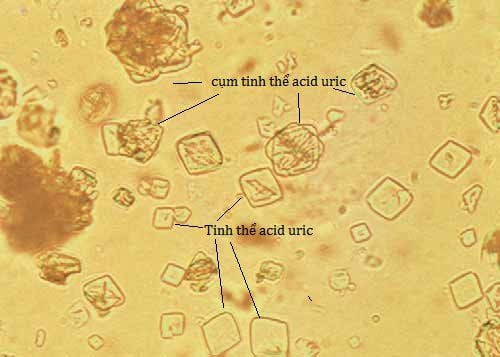
Có nhiều loại tinh thể nước tiểu khác nhau, tồn tại dưới các hình dạng khác nhau
3. How to diagnose urine crystals?
If urine crystals are suspected, the doctor will order a urinalysis. In some cases, a urinalysis is indicated as a general health check, when no risk of crystals has been detected.
You will need to provide a urine sample at the request of the laboratory staff. Under the naked eye, test strip and microscope, the technician will fully determine the nature of the urine and determine if there are crystals in the urine.
Depending on the results of the urine test, the doctor may order other tests. For example, if there is bilirubin in your urine, your doctor may order additional blood tests or an ultrasound to evaluate liver function. If the urine contains cholesterol crystals, blood tests may be ordered to evaluate blood cholesterol levels.
4. How to prevent urine crystals?
Urine crystals that are not caused by an underlying medical condition such as liver disease or genetic disease can often be prevented through lifestyle or dietary changes.
The most effective way to prevent urine crystals is to drink more water. This helps dilute the concentration of chemicals in the urine, preventing crystals from forming.
You can also make some dietary changes such as cutting down on protein, for example, reducing foods high in oxalates (as is the case with calcium oxalate crystals) and limiting salty and salty foods processed.
Please dial HOTLINE for more information or register for an appointment HERE. Download MyVinmec app to make appointments faster and to manage your bookings easily.
Reference source: Healthline.com



